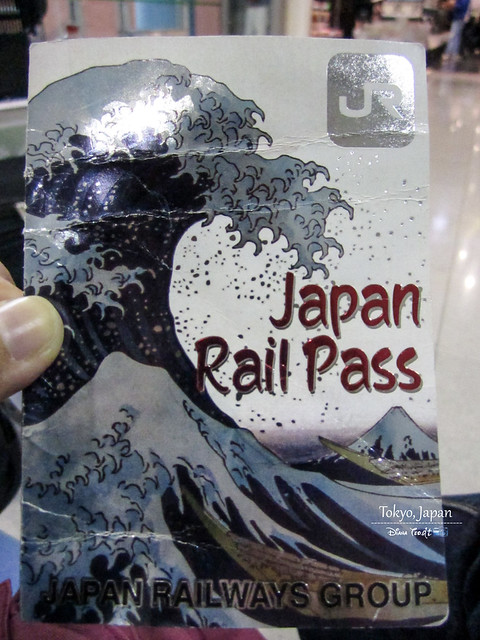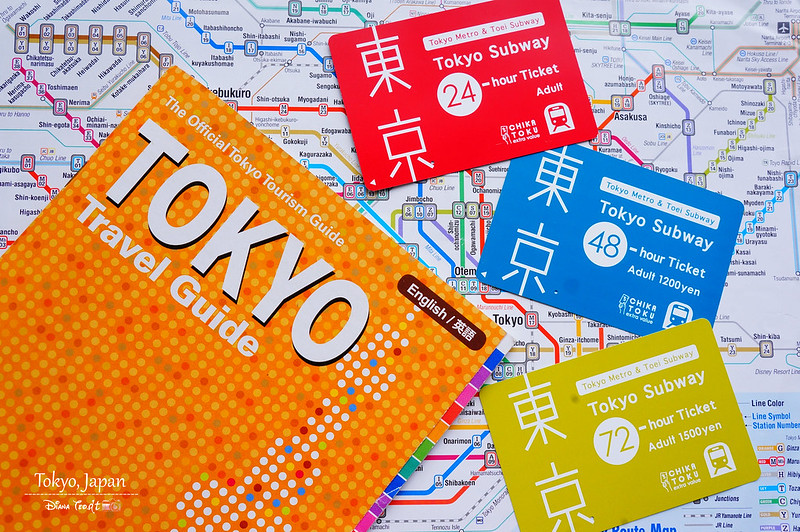When talking about Japan's public transportation network, can't deny it leads the world in terms of efficiency, safety, cleanliness and comfort. Almost of the places in Japan, especially the major attractions can easily reach by taking their public transportation including the majestic Mount Fuji. However when I seriously look into their multi-layered public transport map for the very first time, it makes my knee getting weak and I can feel the sweat break on my brow.
Just by looking at Tokyo underground network alone, I can honestly say it's the most complicated, confusing and messy things I ever came across in my life. More challenging than my solo backpacking trip around Europe. Not even before I can fully digest the network system, here comes another issue - which ticket or Pass should I get? No wonder for those who been to Japan before, according to them you need to do a thorough research if you are planning to go Japan on your own. But don't let this dampen your dreams of going there.
Now, let us back to the main topic - which ticket, pass or card should one consider when travelling to Tokyo? Which is more worth to suit your needs and preferences?
Japan Rail (JR) Pass
While getting a JR Pass may seems to be the most popular choice for foreign visitors, actually it's not a wise choice if your intention just to cover Tokyo city only during the duration of your trip. Even if you plan to include Yokohama and visit Mount Fuji, but still I don't think it's worth to buy JR Pass for this scenario. A 7-day JR Pass costs ¥29,110 (approx. to RM1,164) my dear and therefore, do plan your trip ahead.
JR Pass is only worth if you are covering few regions within a week - take for example, both Kanto and Kansai regions where the travelling takes place between Kyoto or Osaka (Kansai Region) to Tokyo (Kanto Region) and for a single-trip with Shinkansen (bullet train) only, it might costs ¥13,620 for unreserved seat. This is where you should consider of getting JR Pass. In Tokyo itself, you can use this pass for JR Yamanote Line, a circular loop line that does cover major areas such as Shibuya, Harajuku, Shinjuku, Ikebukuro, Ueno, Akihabara and Tokyo Station.
For more information about Japan Rail Pass, check out the official website here.

Tokyo Subway Ticket
With 9 Tokyo Metro lines and 4 Toei Subway lines, you may consider to get a discount ticket for unlimited rides on the train.
The most common ticket I bought is the 24/48/72-Hour Tokyo Subway Ticket as it covers all Tokyo Metro lines and Toei Subway lines, which serve most of central Tokyo. Depending on the distance, a single fare train ride ranging between ¥110 to ¥310. If you are hopping on and off at least more than 4 stations, then you should get yourself any of the above discounted tickets compared to single-use ticket. These ticket are valid from the first activation time until the same time on the next day (for example, if you activate the 24-hour ticket at 8.30pm on 1st January, you can use it until 8.30pm on 2nd January). Want to know more about Tokyo Subway Ticket, read here.

Prepaid Fare Cards (Suica and Pasmo)
Both of these Suica and Pasmo cards are similar to our Malaysia's Touch 'n Go card. For an initial deposit of ¥500, you can reload or top-up as you go along. In addition, fares are usually lower than when purchasing tickets at ticket machines in Tokyo. These cards can also be used as electronic money for your purchases at convenience stores and some restaurants too. You can return the cards for a refundable deposit by end of your trip. My advise - not to return it cause these cards can used throughout the entire Japan. Why not keeping your card for your next Japan trip instead, like I do?

However, do take not that there are several attractions are not under Tokyo Metro and Toei Subway lines, such as Tokyo Disneyland & Disneysea, Toyosu Market (new fish market replacing Tsukiji) and also Odaiba (popular for life size Unicorn Gundam Statue). Hence, the discounted tickets are not valid to use for these above mentioned places, except Tokyo Furii Kippu which still can be applied to get to Tokyo Disneyland & Disneysea. Somehow, I still think it's not worth to get that particular ticket cause a-single fare from Tokyo Station to Maihama Station (nearest station) along JR Keiyo and JR Musashino Line for ¥220 only.
And please, please, please do always bring along your passport cause according to Japan regulations, any foreign tourists MUST have their passport with them at all times. Even when they will request for your passport when buying either passes, tickets or cards in order to prove that you are foreign visitors, not the local Japanese.
My Other Posts Of Tokyo:
For more information about Japan Rail Pass, check out the official website here.

Tokyo Subway Ticket
With 9 Tokyo Metro lines and 4 Toei Subway lines, you may consider to get a discount ticket for unlimited rides on the train.
Tickets | JR | Tokyo Metro | Toei Metro |
Tokyo Tour Ticket (Tokyo Furii Kippu) Available at JR stations in Tokyo area at some reserved-seat ticket machines and JR Ticket Offices as well as tickets machines at Tokyo Metro Stations or Toei Subway stations. It also covers city bus lines. Adult ¥1,590, Child ¥800. Valid Period: One day | ü | ü | ü |
Tokyo Subway Ticket Available at the counters at Haneda Airport, Narita Airport and BIC Camera. It also can be bought from most major metro offices. There are three type of tickets: 24-hour – Adult ¥800, Child ¥400 48-hour – Adult ¥1,200, Child ¥600 72-hour – Adult ¥1,500, Child ¥750 | ü | ü | |
Tokyo Metro 24 Hour Ticket Adult ¥600, Child ¥300 | ü | ||
Toei One-Day Economy Pass (Toei Marugoto Kippu) On the day of use, passes are available at ticket machines in all Toei subway stations and Nippori-Toneri Liner stations. It also cover Toei buses and streetcards. Adult ¥700, Child ¥350. Valid Period: One day | ü |
The most common ticket I bought is the 24/48/72-Hour Tokyo Subway Ticket as it covers all Tokyo Metro lines and Toei Subway lines, which serve most of central Tokyo. Depending on the distance, a single fare train ride ranging between ¥110 to ¥310. If you are hopping on and off at least more than 4 stations, then you should get yourself any of the above discounted tickets compared to single-use ticket. These ticket are valid from the first activation time until the same time on the next day (for example, if you activate the 24-hour ticket at 8.30pm on 1st January, you can use it until 8.30pm on 2nd January). Want to know more about Tokyo Subway Ticket, read here.

Prepaid Fare Cards (Suica and Pasmo)
Both of these Suica and Pasmo cards are similar to our Malaysia's Touch 'n Go card. For an initial deposit of ¥500, you can reload or top-up as you go along. In addition, fares are usually lower than when purchasing tickets at ticket machines in Tokyo. These cards can also be used as electronic money for your purchases at convenience stores and some restaurants too. You can return the cards for a refundable deposit by end of your trip. My advise - not to return it cause these cards can used throughout the entire Japan. Why not keeping your card for your next Japan trip instead, like I do?

However, do take not that there are several attractions are not under Tokyo Metro and Toei Subway lines, such as Tokyo Disneyland & Disneysea, Toyosu Market (new fish market replacing Tsukiji) and also Odaiba (popular for life size Unicorn Gundam Statue). Hence, the discounted tickets are not valid to use for these above mentioned places, except Tokyo Furii Kippu which still can be applied to get to Tokyo Disneyland & Disneysea. Somehow, I still think it's not worth to get that particular ticket cause a-single fare from Tokyo Station to Maihama Station (nearest station) along JR Keiyo and JR Musashino Line for ¥220 only.
And please, please, please do always bring along your passport cause according to Japan regulations, any foreign tourists MUST have their passport with them at all times. Even when they will request for your passport when buying either passes, tickets or cards in order to prove that you are foreign visitors, not the local Japanese.
My Other Posts Of Tokyo:





Looking at the network map, I go dizzy. Lol. More complicated than the London tube map.
ReplyDelete